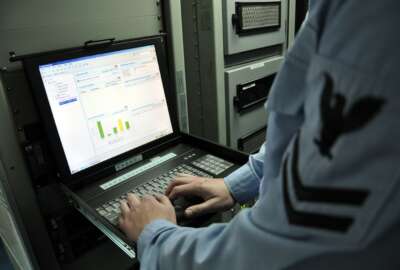Navy seeks to break its buy, replace technology model
One of Jennifer Edgin's, the Navy's assistant deputy chief of naval operations for information warfare, goals is to ensure technology is onboarded quickly and is...
SAN DIEGO — Like almost all agencies, the Department of the Navy does a good job of buying and replacing old technology. Where the DoN, and most others struggle is how to sustain that application or system over the long term.
Jennifer Edgin, the assistant deputy chief of naval operations for information warfare, said her office is leading a perspective shift to ensure technology is onboarded quickly and is always modernized.

“It used to be you would buy a system, a box that was contained with hardware, software, all different types of things and use it until its end of life. Then you replace it with the next best thing,” Edgin said in an interview with Federal News Network at the AFCEA West conference. “As cloud computing and other cloud-based technologies have come online, it changes that model. The Defense Innovation Board had a great quote. It said software was never done. So when we talk about sustainment, we are talking about the iterative updates, the update of software, the update of different capabilities and new things that come online. That’s a mindset shift. That’s what you see kind of permeating across a lot of the conference talks that we’re having out here and a lot of the perspectives that we’re trying to drive as a resource sponsor. Changing our mindset from a buy and replace to a buy and sustain so that our sailors can get updates when they need them, how they need them to face whatever they may be facing at sea.”
The mindset comes from initiatives like the Navy’s Black Pearl software development platform. It comes from the success of Operation Flank Speed to give more than 600,000 sailors, seamen and civilians access to modern workplace applications in a secure cloud.
Jane Rathbun, the DoN chief information officer, said giving sailors, seamen and civilians access to platform- and software-as-a-service that meets the Defense Department’s zero trust requirements through Operation Flank Speed underlies this new approach.
“We are encouraging and driving to the optimal use of that platform so that we can get out of on-premise servers and get out of shared drives and things like that. We really want to take advantage of the cloud platform that is so agile for us and will allow us to maneuver in places that we have not been before,” Rathbun said in an interview on Ask the CIO. “We’re testing out Flank Speed on a ship. We put a hyperconvergence infrastructure stack on the ship so that we could drive to, what the secretary would like to see, is email for life for our sailors. I think you’re probably well aware that today when you’re going to ship, you get a new email address. If you’re the commodore of multiple ships, you have multiple email addresses. It seems maybe not one of the most important priorities that we could be working on, but I think if we’ve got the technology, the technology is demonstrating that it can work, we should start evolving and improving the experience of the sailor.”
The aircraft carrier the USS Abraham Lincoln will test the hyperconverged infrastructure version of Azure, using different connections including low-earth orbit satellites or other access methods.
Navy modernizes records management
Rathbun said the Operation Flank Speed is an evergreening approach, meaning because it’s updated all the time, understanding how it works afloat is important.
“We also are looking at what unclassified applications could we store in that environment that could be leveraged on the ship? Think personnel training and logistics kinds of capabilities,” she said.
Rathbun said Operation Flank Speed is more than just email. The Microsoft Azure platform will let users develop applications at no or low cost, which is much different than the old way that relies on program managers and acquisitions.
A recent example that the DoN CIO implemented recently is around records management.
Rathbun said the Marines Corps started using Office 365 suite tools to manage a majority of their records and the DoN CIO saw that success and expanded the mandate to all of the Navy.
The new approach replaces the DoN Tasking, Records and Consolidated Knowledge Enterprise Repository (TRACKER). The Program Executive Office Digital worked with the Naval Network Warfare Command to test out a minimal viable product moving more than 20 million records to the new system.
Once the National Archives and Records Administration (NARA) confirmed the MVP worked, the DoN CIO made this new approach the only way forward.
The Navy is considering using a Microsoft capability called Form Recognizer, which relies on artificial intelligence technology that lets users upload files and extrapolate text, whether handwritten or types, from forms, to further expand the records management capabilities.
Breaking up requirements
The move of records management to Office 365 is also a good example of another piece of this change that Edgin is pursuing. She said separating the functional requirements from the technical requirements is also part of this effort.
“When you say things like no code, low code, those are design parameters or technical requirements that we can put in place. The functional requirements are from a user’s viewpoint. I’m a sailor on a surface vessel, and I need to be able to accomplish A, B and C. That’s a great functional requirement,” she said. “If we look today, all of those things are integrated together. One of the things that we’re doing from our role as a resource sponsor is separating them because low code, no code could be what we use today, but maybe there’s a great computer advancement a year from now. The functional requirement is still valid, but how we meet that requirement could change. That’s where separating these two things will allow us to iterate very, very fast.”
Generally speaking, functional requirements remain relatively stable, while the technical side can change rapidly. Edgin said that is why having a good governance process with the technical side, the user community and industry also is key.
Edgin said the Navy needs to create an ecosystem that can support not only the separation of the technical and functional requirements, but also the ability to iterate software capabilities faster.
She said that ecosystem must be based on application programming interfaces (APIs) and driven by the people, processes and technologies.
The Navy recently addressed a key piece of the ecosystem by updating one of its main cyber policies last year.
Edgin said the old policy didn’t specify the role that everybody played in this modern technical ecosystem.
“We spent some time last year getting that policy right. I like to say we invited everyone to Thanksgiving dinner and put the place cards out, and now everybody’s really seated at that table,” she said. “Things from the technical side of our acquisition arm, where do they come into play here? Where does our fleet come into play here? How do we look at cybersecurity compliance and then the authority to connect? So where does the network owner, the platform owner come into this? We spent some time really getting that right, getting a governance structure right for how we make decisions and how we interact. The next hurdle that we’re climbing over is the playbooks. How do these work? How do we define those business process? That’s what we’ll be releasing in the next year.”
Copyright © 2025 Federal News Network. All rights reserved. This website is not intended for users located within the European Economic Area.
Jason Miller is executive editor of Federal News Network and directs news coverage on the people, policy and programs of the federal government.
Follow @jmillerWFED








